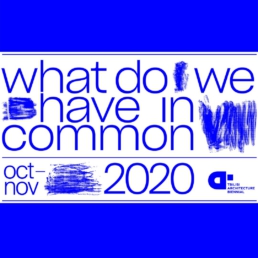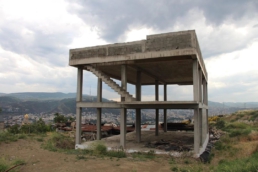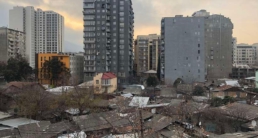When the board of the Tbilisi Architecture Biennial decided on this year’s theme: ‘What do we have in common?’, they didn’t anticipate how fitting it would be.
“With the sudden shifts in our lives from the ongoing pandemic, it became clear that ‘we are in all this together’ – nobody is spared from the effects of the virus and this has drawn us closer,” says co-founder Tinatin Gurgenidze.
Despite the topical question, curating a biennial in the midst of a global pandemic brought with it new challenges that had never been addressed by the team before.
“We’re having to completely reinvent it”, Tinatin says, “the main challenge is trying to reach people through virtual media and make all the ideas as interactive and interesting as possible”.

This year, the projects will be curated online – placed in a virtual structure that draws inspiration from Corbusier’s Le Domino.
The structure is a typical symbol stemming from the 00s construction boom in Georgia – a bare skeletal frame that has been left half-finished.
“They are seen everywhere throughout the country, we even have a special name for it – shavi karkasi”, says Tinatin.
The framework will host live-streamed workshops, and also exhibit digital works and physical projects from around the world.
“We’ve also played with many ideas – for example in one installation in Milan, everything that happens inside will be live-streamed.”

Aside from its virtual context, the theme allows for a specific focus on common spaces – a typology that can often be overlooked in the realm of architecture.
The position of such public spaces play a revealing role in post-socialist countries such as Georgia, which have witnessed a painful transformation from planned to market economy.
“Our “collectively” organized society became increasingly individualized, the planned urban spaces turned into more fragmented and divided ones. An entire process of urban and socio-economic transition seemed to forget the feeling of common space and collectivity”, reads this year’s introduction.
Staircases, patios, roofs, public parks, squares, unused buildings, and shared self-governed open spaces are among the places that will be explored.
Tinatin observes that often it is such places that have been at the pinnacle of urban transformation.
“Spaces of common inhabitation and collective use have become predominantly infrastructural, turning instead into spaces of transition and uninterrupted functionality”, she notes.
Together the biennial hopes to study and research such spaces by investigating ownership structures, “common” space transformations, everyday spatial common practices, and spaces of resistance.

COVID-19 has played a significant role in bringing to light the importance of such common spaces, particularly outdoor ones which have undergone somewhat of a revival in terms of re-use.
Common areas are re-imagined, and as the legacy of shared spaces are reignited, new lines between the public and private are drawn on informal terrains.
According to Tinatin, “The most important thing one can take from this years’ biennial, is that it gives an opportunity to think about our common spaces of inhabitation, and understand the importance of sharing and co-inhabiting them.”